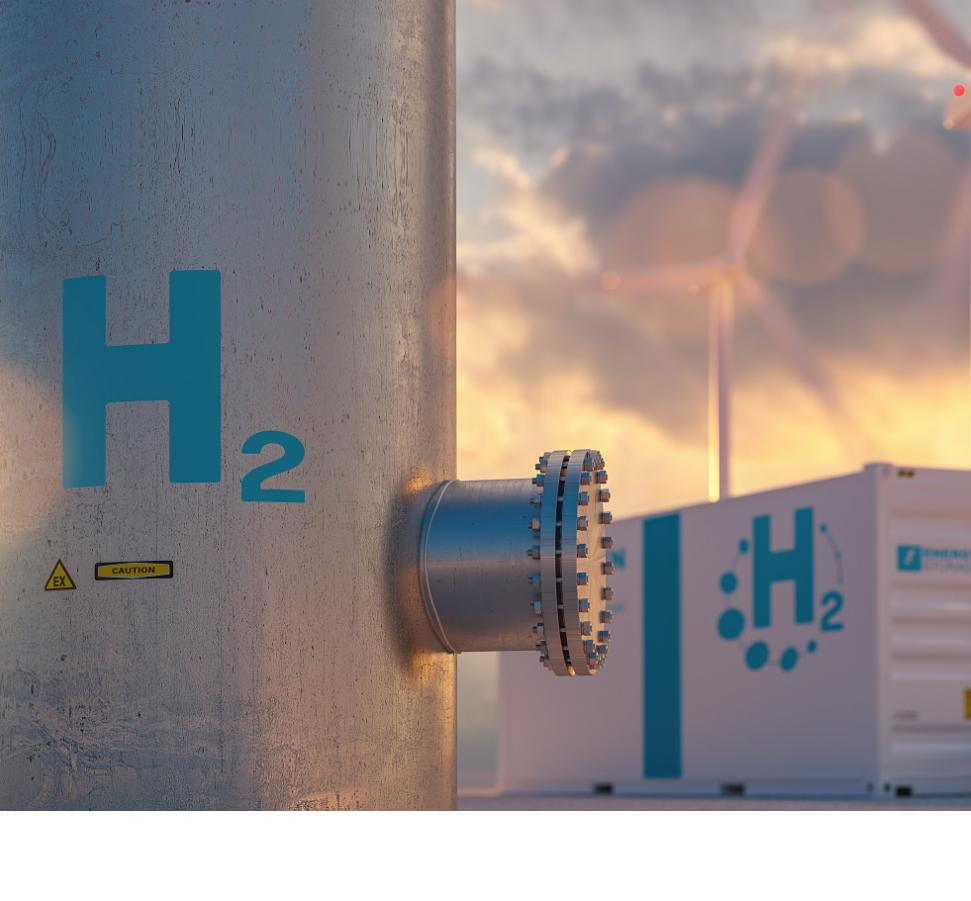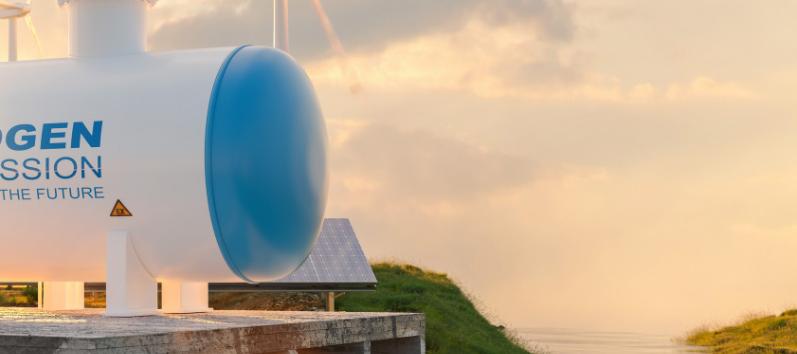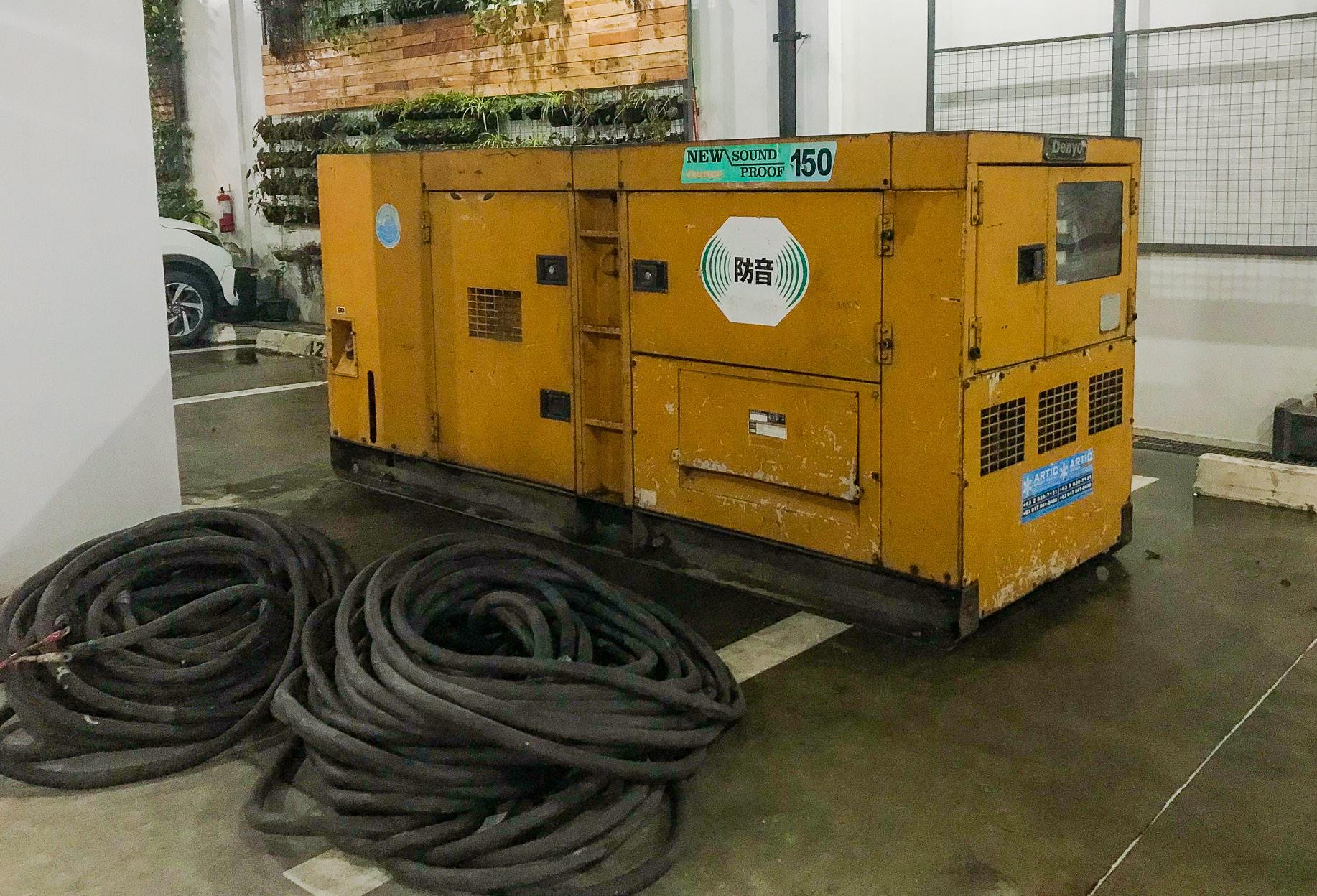Green Hydrogen and Fuel Cell Technology in the



Philippines:
POTENTIAL FOR URBAN AND REMOTE APPLICATIONS
AboutThis brochure has been developed on behalf of the Deutsche Gesellschaf für Internationale Zusammenarbeit (GIZ) Manila to promote the use of renewable energy in the Philippines as a prerequisite to explore green hydrogen applications in the country. Its content is based on a study the German-Philippine Chamber of Commerce and Industry (GPCCI) conducted on behalf of the Federal Ministry for the Environment, Nature Conservation, Nuclear Safety and Consumer Protection (BMUV) in 2022. Said study researched the market potential of green hydrogen generation and its reconversion through fuel cell technology into electricity in the Philippines and included the identifcation of potential early technology adopters. The focus was to identify the potential to replace emergency diesel generators in urban areas and diesel generators in of-grid areas with hydrogen and fuel cell technology.


In Partnership with
Contents
Background
The Energy Situation in the Philippines Technology – Green Hydrogen and Fuel Cells
The Hydrogen Color Spectrum How is Green Hydrogen produced? Advantages
Potential and Current Applications in the Philippines Government Initiatives Hydrogen Potential Assessment Development Partnerships Legal Framework Academic Advances Private Sector Initiatives Germany’s Initiatives Abroad

Philippines
1............. 1............. 2............. 3............. 4............. 5............. 7............. 8............. 8............... 9............... 10............. 11............. 13........... 13...........
Green Hydrogen and Fuel Cell Technology in the Philippines
BACKGROUND
As an archipelago in the pacifc, the Philippines is vulnerable to climate catastro phes such as storms and rising sea levels. At the same time the country is depending on climate-harming fossil fuels to meet its in creasing energy demand.
To address the efects of climate change, the government has committed to reduce greenhouse gas emissions by 75% by 2030 and expanding the use of renewable energy sources to 35% at the same time. This opens possibilities for the public and private sector to explore zero-carbon energy alternatives and to unlock green market potentials.
CURRENT ENERGY SITUATION
The Philippines is facing a dilemma on how to address the rising energy demand and costs. At the same time, 1.63 million Filipino households are still not connected to the grid. This is mostly due to the Philippines’ dispersed geography of more than 7,000 islands.
This widening gap between supply and demand has forced many Filipinos to rely on diesel generators for power generation and for emergency backup power, especially in remote areas.
According to experts, the country’s natural gas supply will dwindle around the year 2026. The Coal Moratorium of 2020 will additionally lessen the use of fossil fuels to generate power.
The Philippines needs to address the widening gap between electricity supply and demand.
The country’s abundant natural resources such as geothermal, wind, and solar energy, are already sustainable energy alternatives. Currently, renewables contribute about 21% of the energy mix with the government’s National Renewable Energy Plan aiming to reach 15,304 MW by 2030, especially with solar roofop installations becoming an accessible solution in commercial and household use.
1
1+ Installed generating capacity 5+ Power generation Natural Gas 13% Oil based 16% Renewable Energy 29% Coal 42% Coal 57.6% Renewable Energy 21.2% Natural Gas 19.2% Oil based 2% Figure 1 The Philippine Energy Mix Source: Department of Energy (DOE), Energy Transition Talk 2021
TECHNOLOGY – GREEN HYDROGEN AND FUEL CELLS
The Philippines’ current power generation capacity from fossil fuels cannot realize the country’s energy needs in an environmentally friendly manner. Nor is it in line with the government’s climate goals. Its goal of energy selfsuficiency also requires new ways of generating and distributing electricity. The Department of Energy is therefore intensifying eforts to use renewable energy sources and modernize the main grids. It is also focusing on energy storage systems for more weather-independent power supply.
Green hydrogen is yet another emerging carbonneutral alternative with considerable benefts and applications. Hydrogen is the most abundant element in the universe. It is widely used in the production of fertilizers, petroleum refning, and energy storage among others.


Through fuel cell technology, it can produce power, heat, and electricity. This opens new possibilities for hydrogen use in transportation, manufacturing, and commercial applications.

2
The Hydrogen Color Spectrum
What makes green hydrogen green? To use hydrogen it must frst be separated from other elements it usually binds to. This process requires energy. Only if the energy used to generate hydrogen comes from a renewable energy source, it is then considered “green”. To identify the energy source that generated hydrogen in the frst place, a color spectrum has been es tablished.
A quick guide to the Hydrogen color spectrum
Black/Grey Hydrogen
Originates from fossil energy sources in an environmentallydamaging process that involves releasing carbon dioxide and carbon monoxide into the atmosphere.
Blue Hydrogen
Sourced from natural gas and produced through steam methane reforming, but carbon dioxide is trapped instead of released.
Red Hydrogen
Produced through electrolysis using electricity generated from nuclear energy.
Green Hydrogen
The only zero-carbon and environmentally-friendly variant of hydrogen that is derived from renewable energy sources.
Black and Grey hydrogen is produced using fossil fuels and is considered to be the most environmentally harmful variant.
Blue hydrogen is generated using natural gas, but the carbon dioxide has been trapped.
In contrast, green hydrogen is the only carbon-neutral variant because it is generated through non-carbon emitting renewable energy sources like wind and solar. Green hydrogen functions as a carrier of clean energy, aiding the goal of decarbonizing our industries.
3
Sources: National Grid, “The Hydrogen Colour Spectrum” World Economic Forum, “Grey, Blue, Green – Why are there So Many Colours of Hydrogen?”, 2021
But how is Green Hydrogen produced?
Renewable energy is generated, e.g. through a solar photovoltaic system.
Energy powers an electrolyser, which separates hydrogen from oxygen.



Green hydrogen is then compressed and stored in fuel tanks for later use.
When renewable energy sources are not available, stored green hydrogen is used as back-up power.


Green hydrogen is channeled through a fuel cell and is converted into electricity.
Clean and green electricity can now be utilized to power appliances.

4
Green Hydrogen Advantages 01
A ZERO-CARBON ENERGY CARRIER
When generated through renewable energy sources, green hydrogen becomes a carbon-free energy carrier that can be stored in fuel tanks.
LONG-TERM STORAGE SOLUTION
Hydrogen tanks have a larger storage capacity than lithiumion batteries and are easy to scale.




Through fuel cell technology, green hydrogen can then be converted back into electricity when renewables are not available, e.g. at night or during adverse weather conditions.
AN ALTERNATIVE TO DIESEL BACKUP POWER
Green hydrogen and fuel cells are an environmentally-friendly alternative to diesel generators that are ofen used to power remote areas or for backup power.
It is especially viable when renewable energy is already being harnessed, e.g. through roofop solar installations.
5
02
03
05

FUEL PRICE INDEPENDENCE
Especially when used in remote areas that require extensive logistics to receive diesel, green hydrogen and fuel cell technology are independent from fuel price uncertainty and added logistics costs.

NO NOISE AND SMELL POLLUTION
Harnessing renewable energy sources to generate green hydrogen and its reconversion through fuel cell technology into electricity omits the noise and smell pollution that is associated with diesel generators.

PROMISING MARKET POTENTIAL
The worldwide green hydrogen market is projected to reach around $90 billion by 2030. In the Philippines, major telecom operators are already using methanol reformers and fuel cells to power remote telco towers.


6
06
04
Potential and Current Applications in the Philippines
Green hydrogen and fuel cell technology are still in the pre-commercial phase in the Philippines. No market-ready applications were identifed during research conducted by the German-Philippine Chamber of Commerce and Industry (GPCCI) on behalf of the Federal Ministry for the Environment, Nature Conservation, Nuclear Safety and Consumer Protection (BMUV) in 2022.
However, especially of-grid areas that use diesel generators for electricity generation and are generally poorly serviced could potentially beneft from fuel cell technology. The new microgrid law could facilitate market entry in this regard. The introduction of the Renewable Portfolio Standard also provides more opportunities to integrate new technologies.
The Philippines is one of the countries with the most diesel generators. About 5% of the country’s diesel and 2% of its gasoline consumption is used to power diesel gensets. Increasing foreign investment, projected economic growth, and infrastructure strengthening will further expand the use of diesel generators in the absence of economically feasible alternatives.

According to the Institute for Energy Economics and Financial Analysis, the Philippines could save USD 66 million to USD 82 million within the next 10 years if the country shifed to alternative energy sources to generate power and thus eliminated diesel transportation costs.
It is anticipated that the cost of green hydrogen production will fall rapidly as the necessary technology, e.g. electrolysers and renewables, become less expensive as they are commercialized. The increase in the cost of CO2 emissions from fossil fuels could further improve the competitiveness of green hydrogen.
7
A diesel generator typically used in the Philippines
Government Initiatives
The Philippine government considers hydrogen as “fuel of the future”, as another alternative and clean energy source.
HYDROGEN POTENTIAL ASSESSMENT
The country’s energy plan recognizes the wide range of applications of hydrogen from distributed power to emergency power, portable power, and as fuel for cars and trucks. In November 2020 the Hydrogen and Fusion Energy Committee (HFEC) was established and a study initiated to explore hydrogen’s potential use. The analysis examined how hydrogen and fusion energy could be incorporated into the energy mix and what applications might be appropriate for the country. The following three scenarios were analyzed:
Scenario 1
Scenario 2
Hydrogen for Power Generation - As backup power for the electric grid and as an alternative power supply option for of-grid areas, especially with variable renewable energy sources (solar and wind) for power plants;
Hydrogen for Transportation - Approximately 10% penetration rate for hydrogen as a replacement for gasoline and diesel vehicles; and,
Scenario 3
Combining Energy and Transportation - Using energy and transportation based on optimal hydrogen production.
For the hydrogen production, three options were identifed:
According to the Philippine Energy Plan, the frst study was completed in February 2021. The results showed the potential benefts of using hydrogen as an alternative energy source, provided non-fossil fuels are used as source material. It was recommended to continue working with interested stakeholders to explore the inclusion of hydrogen in the country’s energy mix and to address current gaps and challenges, especially related to infrastructure and regulatory framework.
8
01 02 03 with renewable energy sources such as solar,
biomass,
and even nuclear power GREY HYDROGEN BLUE HYDROGEN GREEN HYDROGEN with coal
fuel source for production with natural gas
wind,
geothermal,
as the
DEVELOPMENT PARTNERSHIPS
On January 29, 2021, the Australian hydrogen research and development company Star Scientifc Limited has signed a memorandum of understanding with the Philippine Department of Energy (DOE) to advance the development of green hydrogen. Cooperation goals include investigating the potential to retroft existing plants, utilizing ofshore wind resources, exploring uninhabited islands as sites for energy systems, and using the Star Scientifc-branded HERO (Hydrogen Energy Release Optimizer) system for seawater desalination.
In 2018, the National Electrifcation Administration (NEA), signed a memorandum of understanding (MoU) with Toshiba Energy Systems and Solutions Corporation to implement H2One™. H2One™ is an integrated system that uses a renewable energy source to electrolyze water to produce hydrogen and uses fuel cells to enable reverse power generation. An independent, distributed energy system is envisioned to provide clean and stable energy to islands, replacing diesel generators. The MOU includes the identifcation of potential installation sites, optimal system specifcations, operating systems, and maintenance parameters.
The Philippine government continues to reafirm its goal of being energy selfsuficient in the face of growing energy challenges. The Department of Energy is working to promote the use of renewable energy and the modernization of the main grids. It is also focusing on energy storage systems for weather-independent power supply. The directive on integrating hydrogen into the Philippine energy mix makes it clear that the priority is to ensure the country’s energy security, not the imminent export of hydrogen.
The same year, the DOE signed a second memorandum of understanding on hydrogen with the Japanese company Hydrogen Technology Inc (HTI) to research the use of hydrogen in power generation. The collaboration is intended to advance hydrogen research and development activities. According to the Energy Plan 2020-2040, Israel has also expressed interest in studying the islands’ power supply.
In addition to power supply, the potential of hydrogen fuel cells to power cars, trucks, buildings, and for emergency power systems will also be investigated. Fuel cells can be used of-grid. This makes them an attractive option for critical load functions such as data centers and telecom towers.

9
Memorandum of Understanding signing between Star Scientifc Limited and the Philippine Department of Energy
LEGAL FRAMEWORK
There are currently no laws in the Philippines that specifcally address hydrogen, fuel cells, and electrochemical energy storage. However, there are initiatives or draf laws to make hydrogen more attractive. The table lists relevant draf legislation on hydrogen and related areas, based on a research paper published by the University of the Philippines.
NR. YEAR NAME OBJECTIVE
1 2010 Senate Bill 2593 Hydrogen Research Promotion and Development
2 2013 Senate Bill 408
Further developed and newly submitted draf legislation based on SB 2593
3 2013 House Bill 387 Electric, hybrid and other alternative fuel vehicles incentives act
4 2018 House Bill 4366 Green Motor vehicles
5 2019 House Bill 1432 Electric, hybrid and other alternative fuel vehicles incentives act
Figure 1. List of draf legislations on hydrogen and related areas
Establishment of the Philippine Hydrogen Re search and Development Center; Promoting the use and research of hydrogen as an alter native energy source
Establishment of the Philippine Hydrogen Re search and Development Center
Support to explore alternative mobility; incen tives for manufacturers of batteries, fuel cells and related technologies
Incentives for the production and import of al ternative fuel / green vehicles
Incentives for the production and import of alternative fuel / green vehicles; excluded are biofuel-powered vehicles
10
ACADEMIC ADVANCES
In July 2021, then President Duterte signed a law creating the Philippine Energy Research and Policy Institute (PERPI), a think tank attached to the University of the Philippines (UP). This evaluates innovations, research and development of energy issues and promotes training programs and degree programs on energy.
Furthermore, research centers and universities in the Philippines are needed to acquire expertise and competence and to train technical personnel focused on hydrogen and fuel cell technology. To date, academic institutions have conducted a few research projects on hydrogen.
Figure 2 shows a list of research institutions with research experience in hydrogen and fuel cell technology and their expertise based on published results.
YEAR RESEARCH INSTITUTE PROJECT NAME
2014 University of Santo Tomas
Nanostructured Electrocatalyst Com posites for Direct Ethanol Fuel Cell: Preparation, Characterization and Per formance Evaluation
FUNDING AGENCY
Philippine Council for Industry, Energy and Emerging Technology Research Development (DOSTPCIEERD)
2016 Green Power: Generating Renewable Energy via Electrolysis of Water using New Power Hybrid Systems
(1) Hydrogen generation using SOEC (2) Energy production using PEMFC
2021 University of the Philippines –Diliman
Development of High-performance and Low-cost Membrane Electrode Assembly for Alkaline Fuel Cells based on Ion/ electron Dual Conducting Cat alyst Layers
Commission of Higher Education, Philippine-California Advanced Research Institute (CHED-PCARI)
Philippine Department of Science and Technology and China Min istry of Science and Technology (DOST-MOST) Joint Research
2021 Clean and Vertically integrated Pure / Applied Hydrogen Research for Next Generation Power Systems, Sustaina ble and Renewable Fuel and Electroly sis Cell Energy Device Technology
Figure 2. Publicly funded fuel cell technology research projects
Commission of Higher Education, Philippine-California Advanced Re search Institute (CHED-PCARI)
11
Private Sector Initiatives
In recent years, private companies have expanded the infrastructure to generate their own electricity with renewable energy technology. For example, solar PV is already being used as an alternative energy source. In large cities and industrial parks, this is done through roofop installations. There is also an increasing number of companies that are striving for climate neutrality by buying from renewable energy providers. Theoretically, these companies could use green hydrogen in conjunction with fuel cell technology as emergency power systems, primarily to replace dieselpowered emergency generators. Especially commercial and industrial players, including those in the manufacturing or tourism sectors, could be interesting early adopters. However, the private sector is waiting for pilot projects to illustrate the technology and demonstrate economic viability.
The use of methanol reformers to power telecom towers is already an interesting starting point that proves the applicability for fuel cell technology in the Philippines. Telecom providers are looking for solutions to better serve rural areas. They also try to replace diesel generators in urban areas to eliminate disruptive factors such as vibration, noise, and harmful emissions. The company Advent Technologies sold more than 100 methanol reformer units to Globe and PLDT/Smart. Here, the methanol fuel cells with about 5-15kw power are used as emergency generators to replace diesel generators. It is estimated that about 3,000 diesel generators will be replaced in the future. However, the production of the required hydrogen-methanol mixture would have to be localized in the Philippines for sustainable operation.
Market leaders in the Philippines’ energy sector are ofen innovators and pioneers with sustainability strategies that go beyond the country’s energy policy.
In 2019, Pilipinas Shell partnered with Air Liquide Philippines to build a hydrogen production plant at Shell’s Tabangao refnery in Batangas City, south Luzon. This plant will produce hydrogen, which the company can use to process other types of crude oil into higher-quality fuels. With the new technology, Pilipinas Shell will be able to capture and liquefy the resulting carbon dioxide for use as fuel on-site or to sell to dry ice or carbonated beverage producers. Completion was expected in late 2020 but was delayed due to the pandemic.
One of the largest energy companies, First Gen of the Lopez family, announced in 2022 the conversion of their gas power plants to produce “clean” hydrogen. AC Energy, another relevant player in the energy sector as well as MetroPacifc Investment Group are also evaluating the potential of green hydrogen.
According to the Philippine Green Building Council, shopping mall operators and local industries are eager to reduce their electricity costs. Many do so through roofop photovoltaic systems. So far, 20 climateneutral buildings have been certifed, and around 70 additional buildings are to be certifed by 2022. Other industrial players in the country, for example the energy-intensive cold chain industry which has a projected growth potential of between 8-10%, has a strong interest in using renewable energy sources as well as energy eficiency solutions to power their operations.
12
Germany’s Initiatives Abroad
WAY FORWARD – H2-UPPP PROGRAM
Germany has taken huge strides toward a comprehensive hydrogen economy that will support the decarbonization of its industries. While Germany’s hydrogen strategy includes other forms of hydrogen, green hydrogen is emphasized as a renewable and sustainable long-term solution.
The International Hydrogen Ramp-Up Program (H2-Uppp), implemented by the GIZ in cooperation with the German Chambers Abroad, accompanies and supports Germany’s eforts to ramp-up the market for green hydrogen (H2) and power-to-X (PtX) applications in selected developing countries and emerging economies in cooperation with the private sector. Commissioned by the German Federal Ministry for Economic Afairs and Climate Action, H2-Uppp focuses on the early stages of green hydrogen project development.
The H2-Uppp program helps to identify, prepare, and accompany the implementation of projects for the production and use of green H2 and PtX application. It also aims to raise awareness and promote knowledge transfer for the development of projects relating to green H2. This approach will help identify cost-efective production paths and uses, pinpoint project opportunities along the value chain, and develop sustainable business models.
H2-UPPP FOCUSES ON THREE AREAS:
Networking & Project Scouting
H2-Uppp supports companies in identifying project ideas and building networks, for example with pro ject partners or potential of-takers. Partners from the private and fnancial sectors are also ofered train ing on green hydrogen, and public-private dialogue is strengthened through conferences and trade fairs.
Public-Private Partnerships (PPP)
H2-Uppp works with private companies to jointly implement pilot projects in the feld of green H2 and PtX. Formal PPPs are set up for this purpose.
Know-How and Capacity Development
H2-Uppp accompanies the various project ideas with in-depth studies and technical trainings. Through specialist conferences, the activities of local institutions are further strengthened, and joint measures are developed to ensure a successful market launch.
13
Support is provided for PPPs along the entire H2 value chain (production, storage, conversion, transportation, and usage) if they focus on public-beneft activities and contributes to the promotion of sustainable development in the project country. The initiatives must have a positive impact on society and the environment in the project country. The content and results of projects must be published. No grants are issued for investments that are to remain the property of the private sector partner.
Criteria for PPP support
01 02 03
Companies must con tribute at least 50% of the volume of the PPP project

Minimum volume of public contribution: EUR 100,000; minimum vol ume of overall PPP meas ure: EUR 200,000
Compliance with sus tainability standards dur ing project, based on a checklist
For more information on H2-Uppp, on support opportunities or to receive the PPP application form, please contact H2Uppp@giz.de.
14
Imprint
Publisher
Deutsche Gesellschaf für Internationale Zusammenarbeit (GIZ) GmbH


GIZ Ofice Manila
10th foor Bank of Makati Building
Ayala Avenue corner Metropolitan Avenue 1209 Makati City, Metro Manila, Philippines

Produced and Designed By
German-Philippine Chamber of Commerce and Industry, Inc. (GPCCI) / AHK Philippinen
8th Floor Döhle Haus Manila 30-38 Sen. Gil Puyat Avenue Makati City, 1234
All rights reserved. Despite greatest care during content research, GPCCI takes no responsibility for the correctness of it.
Editorial Team
Charlotte Bandelow – Deputy Executive Director, GPCCI
Jana Everett – Special Projects Director, GPCCI
Design & Layout
Elenee Ventura – Senior Communications Specialist, GPCCI
15
































